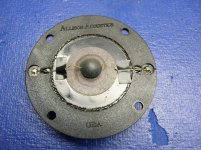I have often wondered the same as the OP. WHere are all the paper dome/cone/inverted dome tweeters?
come to think of it, besides the Focal ones, where are all the inverted domes? paper or not.
It was due to this that i recently bought a pair of Tangband w2-800sl, a 2" 'inverted' dome in Mg/Al alloy. whilst i have no problem with these drivers, (in fact i think theyre great wideband tweeters), I have to say that i expected an inverted dome type of diaphragm to be driven from the circumference, like a dome tweeter.
In the case of the TBs this is not the case. which disappointed me, although im at a loss to explain why, except maybe that i get the feeling a dome (inverted or otherwise) is driven from the circumference for a good reason, maybe better pistonic behavior?
as a slight mod to the OPs question, where are all the driven-from-the-circumference-inverted-paper-or-not-paper-tweeters?

come to think of it, besides the Focal ones, where are all the inverted domes? paper or not.
It was due to this that i recently bought a pair of Tangband w2-800sl, a 2" 'inverted' dome in Mg/Al alloy. whilst i have no problem with these drivers, (in fact i think theyre great wideband tweeters), I have to say that i expected an inverted dome type of diaphragm to be driven from the circumference, like a dome tweeter.
In the case of the TBs this is not the case. which disappointed me, although im at a loss to explain why, except maybe that i get the feeling a dome (inverted or otherwise) is driven from the circumference for a good reason, maybe better pistonic behavior?
as a slight mod to the OPs question, where are all the driven-from-the-circumference-inverted-paper-or-not-paper-tweeters?
I have often wondered the same as the OP. WHere are all the paper dome/cone/inverted dome tweeters?
Lots of vintage paper cone tweeters.
I have to say that i expected an inverted dome type of diaphragm to be driven from the circumference, like a dome tweeter.
One of the advantages of a stiff inverted cone is that it can be driven from the middle of the cone -- at least it makes sense when Focal descibes theirs.
dave
Lots of vintage paper cone tweeters.
yeah, i used to have some 70's era Goodmans cone tweeters (no idea WHAT they were exactly), maybe 3" diameter, with a 1/2" VC and corresponding 'dome' although it was perhaps a fabric dome centre dustcap, it appeared integral to the done. They were pretty good, if a bit tizzy, but great for a 2 way with a 8" woofer and a simple x-o.
One of the advantages of a stiff inverted cone is that it can be driven from the middle of the cone -- at least it makes sense when Focal descibes theirs.
dave
oh its makes sense alright, i assumed that bonding the VC to the bowl of a inverted dome, would be more difficult. the TBs use a paper 'cone' which forms a part of the VC former, and which flares out to meet the circumference of the cone/dome. im still struggling to see is this is actually better than edge bonding, considering the extra mass.
Subwoofers and dust caps, yes, but drivers with conical diaphragms seem like they are made of rolled flat stock.It is a felted paper process. You suck a slurry (particles and a binder suspended in water) through a shaped screen. This is how virtually all cones and dustcaps are formed also, and why you may see the pattern of a screen on one sde of a cone. Some are dryed on the screen and others are forced between two surfaces, giving a smoother outside look.
David
Subwoofers and dust caps, yes, but drivers with conical diaphragms seem like they are made of rolled flat stock.
Yes, that would be a seamed paper cone. There were plenty of those too for straight sided cones. After rolling and seaming you can do a little mild forming to shape the neck and surround attach points, no real shape contouring though.
Regarding the inverted dome and whether it is driven at the perimeter or not, again the geometry is more difficult for the inverted dome. The dome going downward interferes with the magnet structure. Either you hollow it out by cutting into the core pole (middle of magnet circuit iron) or you use a long voice coil former to buy clearance, or you move the voice coil diameter inboard of the dome diameter. Longer voice coil formers mean more weight, not a good thing in a tweeter. There may be some exceptions, but these are all bad compromises. Sketch it out and you can see what I mean.
David S.
Looking closely at my Acoustic Research AR-11 dome tweeters, I think they are made of cloth rather than paper. Anyone know for certain?
Yes, I'm pretty sure they were. classicspeakerpages.net is a great site for AR history.
The AR3 had phenolic mid and tweeter domes, the AR3a were paper. For later models they went to cloth, primarily because earlier units were heavy and had inadequate sensitivity because of it. (moving mass)
David S.
- Status
- This old topic is closed. If you want to reopen this topic, contact a moderator using the "Report Post" button.
- Home
- Loudspeakers
- Multi-Way
- Has there ever been a dome tweeter constructed of paper?
